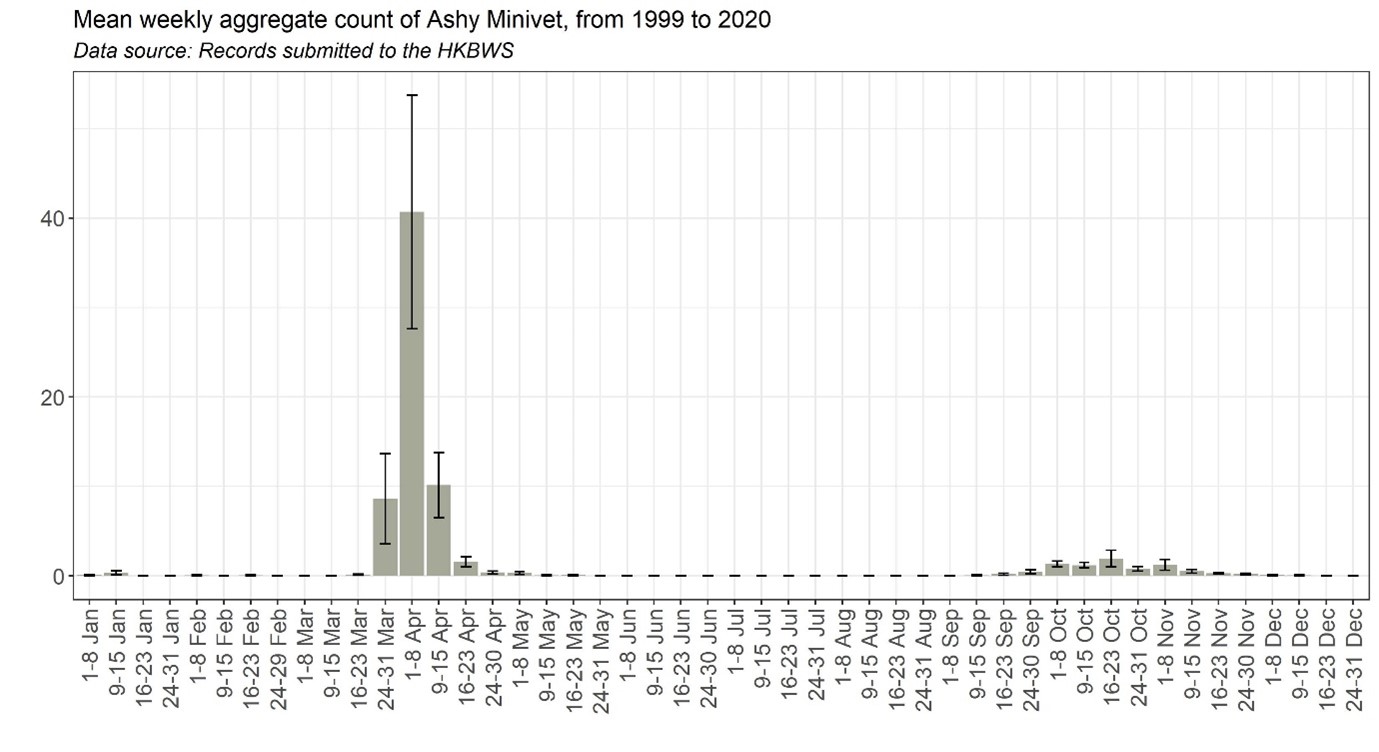Ashy Minivet Pericrocotus divaricatus 灰山椒鳥
Category I. Passage migrant, uncommon in spring and scarce in autumn, and rare winter visitor; occurs in diverse wooded habitats.
IDENTIFICATION

Mar. 2019, Michelle and Peter Wong. Male.
18-21 cm. Distinctive monochrome minivet. Male has black mask that broadens over rear of face, nape and hind crown and contrasts with white fore crown. Upperparts and wing coverts are slate grey, flight feathers and tail are blackish, while the tertials have pale grey outer webs. Outer tail feathers are edged white. The lower face, half collar and underparts are white.

Apr. 2019, Michelle and Peter Wong. Female.
Female has grey crown and upperparts; the blackish mask is restricted to the lores and a band above the bill, which are bordered above by whitish. Flight feathers, tail, underparts and tertials as male.
Immature birds resemble female but greater coverts, tertials and inner secondaries are tipped and/or edged white and the sides of chest and flanks are barred pale grey.
VOCALISATIONS
The call is an inflected, ringing trill. Compared to Swinhoe’s Minivet it is lower-pitched, fuller and usually louder and longer.
DISTRIBUTION & HABITAT PREFERENCE
On migration, Ashy Minivet occurs throughout HK in forests and fung shui woods to more open village areas with trees and large urban parks. It is most frequently recorded on Po Toi, but is regularly recorded elsewhere, including the wetland areas of the northwest New Territories.
OCCURRENCE
Ashy Minivet is mostly recorded in spring when it is concentrated in the last week of March and the first two weeks of April (Figure 1). Extreme spring dates are 18 March 1966 and 2017, and 21 May 2007 and 2008.
Although most records concern singles or no more than a few birds, it is not unusual to record flocks of up to 20 birds, while the highest count was 71 flying past at Mai Po on 31 March 2020. The number recorded is strongly associated with weather conditions, with low cloud substantially increasing the chances of encounter. The strength of passage this century appears to be much greater than the pre-1999 period, but this is likely due to increased observer activity rather than a genuine increase.
Autumn passage, which is more protracted yet less pronounced, is recorded from mid-September to mid-November without an obvious peak. Birds tend to occur singly or in small flocks, the highest count being 20 along Shan King Trail, Tuen Mun on 18 October 2019. Extreme dates are 22 September 2016 and 10 December 2017. There are a very small number of records in January and February, the latest on the 22nd.
Ashy Minivet was first recorded in April 1860 (Swinhoe 1861). Vaughan and Jones (1913) noted it in the Pearl River delta (though not HK) in early April and from late October to early November. During 1930-1941 it was recorded on three dates from 30 March to 15 April (Anon 1931, Herklots 1940, 1941).
BEHAVIOUR, FORAGING & DIET
Often in small groups, and sometimes in larger flocks of more than 20 individuals. The only local observation regarding diet concerns five birds feeding on caterpillars on leaves of Ilex rotunda var. microcarpa, though it presumably feeds on a wide variety of invertebrates as do other minivet species.
RANGE & SYSTEMATICS
Monotypic. Breeds in southeast Siberia, northeast China as far south as Hebei, Korea and Japan; winters in southeast Asia, Sumatra, Borneo, the Philippines and south-central India (Taylor and Kirwan 2020, Liu and Chen 2020).
CONSERVATION STATUS
IUCN: Least Concern. Population trend decreasing.
Figure 1.

Anon. (1931). Notes and Comments. Ornithology. Hong Kong Naturalist 2:141-144.
Herklots, G. A. C. (1940). Notes and Comments. Ornithology. Hong Kong Naturalist 10: 79-83.
Herklots, G. A. C. (1941). Notes and Comments. Ornithology. Hong Kong Naturalist 10: 223-231.
Liu, Y. and Y. H. Chen (eds) (2020). The CNG Field Guide to the Birds of China (in Chinese). Hunan Science and Technology Publication House, Changsha.
Swinhoe, R. (1861). Notes on the ornithology of Hong Kong, Macao and Canton, made during the latter end of February, March, April and the beginning of May 1860. Ibis 1861: 23-57.
Taylor, B. and G. M. Kirwan (2020). Ashy Minivet (Pericrocotus divaricatus), version 1.0. In Birds of the World (J. del Hoyo, A. Elliott, J. Sargatal, D. A. Christie, and E. de Juana, Editors). Cornell Lab of Ornithology, Ithaca, NY, USA. https://doi.org/10.2173/bow.ashmin1.01
Vaughan, R. E. and K. H. Jones (1913). The birds of Hong Kong, Macao and the West River or Si Kiang in South-East China, with special reference to their nidification and seasonal movements. Ibis 1913: 17-76, 163-201, 351-384.

